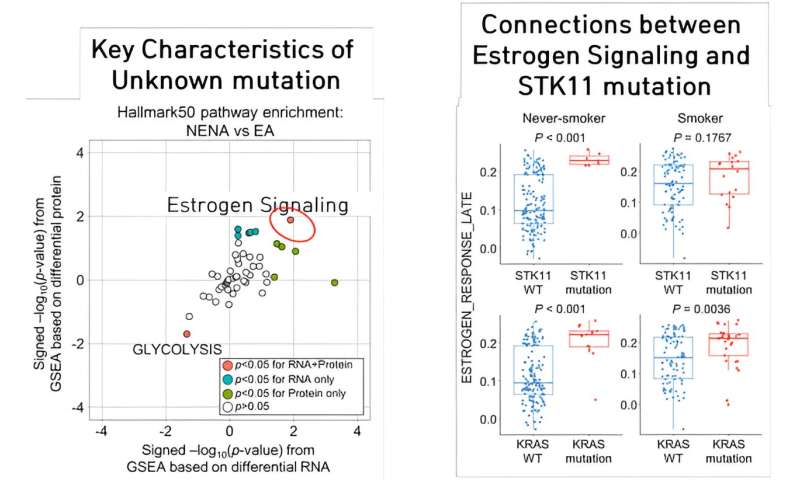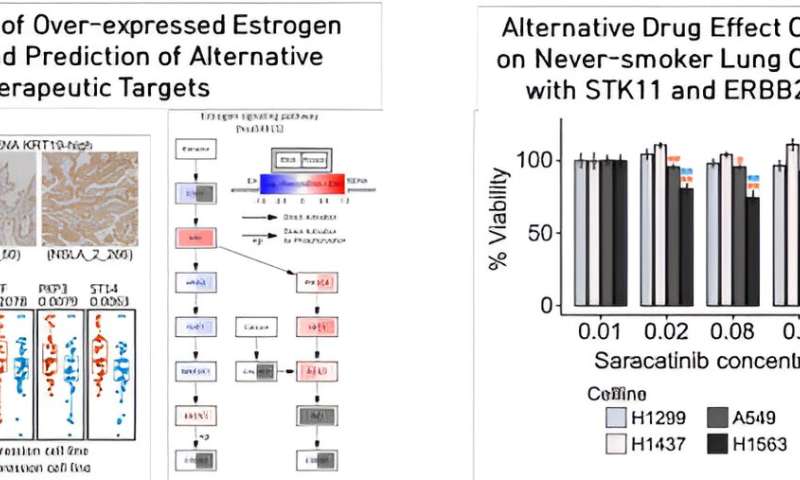The primary cause of lung cancer is smoking. However, the incidence of lung cancer among never-smokers has been steadily increasing, especially among women.
While approximately 80% of never-smoking lung cancer patients are prescribed targeted therapies that focus on mutations in proteins such as EGFR and ALK, the remaining patients often receive cytotoxic chemotherapy with high side effects and relatively low response rates, highlighting the urgent need for targeted therapies.
Dr. Lee Cheolju’s team at the Chemical Life Convergence Research Center at the Korea Institute of Science and Technology (KIST), along with Dr. Kim Seon-Young’s team at the Korea Research Institute of Bioscience and Biotechnology and Dr. Han Ji-Youn’s team at the National Cancer Center, have elucidated the overexpression of estrogen signaling pathways in specific Korean never-smoking lung cancer cases using multi-omics analysis and proposed the anti-cancer drug saracatinib as a targeted therapeutic agent.
The research is published in the journal Cancer Research.
Multi-omics integrates various molecular information, with proteomics presenting a particular challenge due to the need to analyze small amounts of proteins without loss, typically microgram-scale.
The research team obtained tissue samples from 101 Korean never-smoking lung cancer patients without identified treatment targets among 1,597 patients who visited the National Cancer Center over the past decade and distributed clinical information, genomic, transcriptomic, proteomic, and phosphoproteomic data to each omics analysis method for mutual referencing.
Proteomic analysis measured an average of over 9,000 proteins and 5,000 phosphorylated proteins per sample using only 100 μg of protein, which is 10% of the amount required for conventional protein analysis, using isotopic labeling techniques.
-

(Left) Increased expression of genes associated with estrogen hormone response observed in tissues from patients with unidentified mutations in both genetic and protein analyses.(Right) Patients with driver mutations in STK11 and ERBB2 show significant differences in smoking history, and high estrogen response shows similar results to known KRAS mutations. Credit: Korea Institute of Science and Technology (KIST)
-

(Left) Validation of proteins associated with estrogen response using tissue immunostaining, identifying Saracatinib as the most effective drug in inhibiting the expression of related proteins using public bio big data and cross-analyzing its mechanism with genetic expression in Korean never-smoking lung cancer patients to predict positive anticancer effects.(Right) Selection of cell lines with mutations identical to those found in patients among lung cancer cell lines, treated with Saracatinib alongside a control group without these mutations, demonstrating excellent anticancer effects from low to high concentrations and confirming the anticancer effects of Saracatinib. Credit: Korea Institute of Science and Technology (KIST)
Analysis of genetic mutations and cellular signaling pathways revealed that driver mutations of genes known to be associated with cancer, such as STK11 and ERBB2, were observed in the tissues of never-smoking lung cancer patients.
Additionally, while the estrogen signaling pathway was found to be overexpressed, there were no significant changes in estrogen hormone receptors.
Based on this, saracatinib, a sub estrogen signaling transduction protein inhibitor, showed statistically significant (p<0.01) cell death effects when applied to cells with mutations in STK11 and ERBB2 compared to the control group without such mutations.
Building on this, the research team is developing a molecular diagnostic technique for discriminating patients with specific expression of estrogen signaling pathways among never-smoking lung cancer patients. Additionally, they plan to conduct preclinical trials of saracatinib’s therapeutic effects on never-smoking lung cancer animal models in collaboration with the National Cancer Center.
Dr. Lee Cheolju of KIST stated, “This successful case of discovering new therapeutic targets for refractory cancer through multi-omics analysis is based on purely domestic research and the collaborative efforts of hospitals and research institutions, which holds significant meaning. Building on this experience, we will lead the expansion of multi-omics research on human diseases.”
More information:
Seung-Jin Park et al, Proteogenomic Characterization Reveals Estrogen Signaling as a Target for Never-Smoker Lung Adenocarcinoma Patients without EGFR or ALK Alterations, Cancer Research (2024). DOI: 10.1158/0008-5472.CAN-23-1551
Citation:
New pathways for treating never-smoker lung cancer revealed (2024, June 3)
retrieved 3 June 2024
from https://medicalxpress.com/news/2024-06-pathways-smoker-lung-cancer-revealed.html
This document is subject to copyright. Apart from any fair dealing for the purpose of private study or research, no
part may be reproduced without the written permission. The content is provided for information purposes only.

